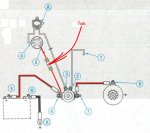FishHunt23
Seaman
- Joined
- Jan 4, 2007
- Messages
- 50
I have a real PITA problem with my 1988 Evinrude 70. There is a short that is causing the fuse in the engine (20A, located in a red boot near where the wire harness from the control box plugs in under the hood) to short on an intermittent basis.
Sometimes it happens when I turn the key. Sometimes it happens when I hit the trim switch. But sometimes it happens even when the ignition key is off, and it'll blow the fuse the second I replace it. Then everything will be 100% fine for months at a time. It's crazy.
I replaced the control wire harness (red plug). I disconnected the dash gauges. I've re-wired everything else (this was a project boat, so I did that anyway). The contol box has been replaced and the problem persists, so it isn't in there.
I figure I've got a worn/bare wire somewhere that is bumping into something. Or a bad ground, though if that were the case I think it would be more consistent.
Does anyone have any advice on where to look for the problem? Locating a short can be a real bear of a project in my experience. Thank you.
Sometimes it happens when I turn the key. Sometimes it happens when I hit the trim switch. But sometimes it happens even when the ignition key is off, and it'll blow the fuse the second I replace it. Then everything will be 100% fine for months at a time. It's crazy.
I replaced the control wire harness (red plug). I disconnected the dash gauges. I've re-wired everything else (this was a project boat, so I did that anyway). The contol box has been replaced and the problem persists, so it isn't in there.
I figure I've got a worn/bare wire somewhere that is bumping into something. Or a bad ground, though if that were the case I think it would be more consistent.
Does anyone have any advice on where to look for the problem? Locating a short can be a real bear of a project in my experience. Thank you.




















